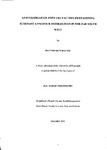AN INVESTIGATION INTO THE FACTORS DETERMINING RUMINANT LIVESTOCK DISTRIBUTION IN THE FAR SOUTH WEST
| dc.contributor.author | DAVIES, DAFYDD HUW | |
| dc.contributor.other | Faculty of Arts, Humanities and Business | en_US |
| dc.date.accessioned | 2013-09-10T11:09:24Z | |
| dc.date.available | 2013-09-10T11:09:24Z | |
| dc.date.issued | 2001 | |
| dc.identifier | NOT AVAILABLE | en_US |
| dc.identifier.uri | http://hdl.handle.net/10026.1/1632 | |
| dc.description.abstract |
Major changes are taking place in all sectors of the livestock and meat producing industries from farm to consumer which impinge on the processes and pattems of livestock distribution from farm to slaughter. These changes are identified and described. A farm business survey of lowland beef and sheep finishers was undertaken, prior to the 2001 Foot and Mouth outbreak, to gain a better understanding of farm business behaviour in order to model the farm business strategies in relation to aggregate livestock channel utilisation. Statistically robust and predictive models using a number of derived latent strategic variables, distilling marketing and business orientations, were used in an adapted multivariate approach. Group profiling confirmed consistency with the cluster profiles. Results show that both lowland beef and sheep producers can be statistically classified into three distinct strategic groups. The marketing approaches that farm businesses use vary according to group membership. For lowland beef producers these are described as selling orientation, buyer focus and differentiation strategies. Sellers view beef production as a minor enterprise to provide supplementary farm income, but fail to meet procurement requirements and are limited to channel utilisation. Buyer focus are production orientated, understand distribution, have good market knowledge and meet procurement standards. Differentiators have similar attributes to buyer focus, but are more likely to differentiate and add value and actively seek markets to which they can sell. Lowland sheep producer strategies are described as opportunist, production and differentiation. Opportunists have similar attributes to sellers, and fail to meet or understand procurement requirements. Producers are as production orientated as buyer focus, but have poorer market and distribution knowledge and tend to focus primarily on production concerns. Differentiators, as with beef finishers, are more likely to differentiate and add value and actively seek markets to which they can sell. The developed typologies reveal that farm business marketing behaviour changes according to group membership and this has a significant influence on aggregate channel utilisation within the Far South West. For some fanners it would appear that channel utilisation is predetermined. | en_US |
| dc.language.iso | en | en_US |
| dc.publisher | University of Plymouth | en_US |
| dc.title | AN INVESTIGATION INTO THE FACTORS DETERMINING RUMINANT LIVESTOCK DISTRIBUTION IN THE FAR SOUTH WEST | en_US |
| dc.type | Thesis | |
| plymouth.version | Full version | en_US |
| dc.identifier.doi | http://dx.doi.org/10.24382/3216 |
Files in this item
This item appears in the following Collection(s)
-
01 Research Theses Main Collection
Research Theses Main


